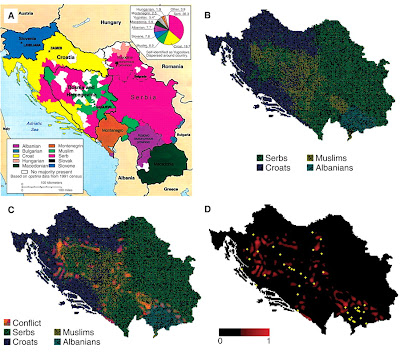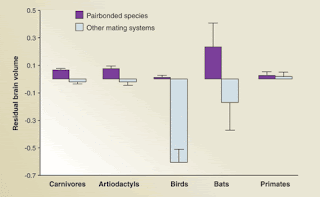Two papers in the new issue of PLoS Medicine review where we are at on this topic.
I'll go over this one first, and the other one later.
Racial Categories in Medical Practice: How Useful Are They? Lundy Braun, Anne Fausto-Sterling, Duana Fullwiley, Evelynn M. Hammonds, Alondra Nelson, William Quivers, Susan M. Reverby, Alexandra E. Shields
PLoS Medicine 4(9): e271
regarding self-identified race:
As genetic findings assume an increasingly prominent place in biomedical research, some have concluded that self-identified race/ethnicity, routinely collected in biomedical research studies, is a reasonable proxy for genetic homogeneity and may lead to important insights into health disparities [36,41–43]. Others, citing the genetic heterogeneity within self-identified groups [44–46], argue that race should not be used in genetic research [47–50]. A related perspective comes from those who argue that self-identified racial/ethnic categories may be practical for recruitment into studies, but should not be used in genetic analyses, given that more biologically precise measures of human genetic heterogeneity are available [17,51]. A recent study of geographic patterns of genetic variation, for example, found that “commonly used ethnic labels are both insufficient and inaccurate representations of the inferred genetic clusters, and that drug-metabolizing profiles…;differ significantly among the clusters” [52].
Then they proceed to give some interesting historical context to the social context of race identification and self-identification.
Box 2 has this interesting and important description of researchers who look at the whole picture of race and health:
Race-related differences in health outcomes can be analyzed at the societal, individual, cellular, and subcellular levels. Studies focusing exclusively on one level often lose track of inter-level connections. Two research groups exemplify efforts to integrate research on health disparities at the level of cellular effects (e.g., on tumor production and growth), of societal level events (e.g., social support or toxin exposure), and individual life history events (e.g., reproductive history, stress, diet).
Epidemiologist Nancy Krieger [80–82] applies the concept of embodiment to an understanding of how the social effects of racism and social inequality become symptoms [83] and illnesses that manifest as racially related health disparities (on embodiment, see also Fausto-Sterling, 2005 [84]). Krieger understands embodiment to be a multilevel phenomenon that serves as “an antonym to disembodied genes, minds and behaviors” [82]. Similarly, Masi and Olopade [85] propose a multilevel perspective on racial and ethnic disparities in breast cancer. Their model illustrates how the dynamics of societal and individual events over the life cycle can have specific cellular outcomes resulting in neoplasms with particular cellular characteristics. To the extent that societal and individual events vary systematically with social race, biological outcomes may result from social inequalities. The key to future understandings of health disparities lies in using frameworks such as those proposed by Krieger and Masi and Olopade to design and interpret research at every level, from the social to the cellular.
and then onto some other diagnostic considerations beyond "race"
Does a quick administrative assessment of race help to diagnose a presenting ailment, or accurately assess future risk of illness? Environmental exposures, family histories, the stress of dealing with racism, access to and quality of care may be left unexamined if a physician simply diagnoses “race” [66]
and finally, some recommendations for medical training and practice:
Improved medical training about race can sharpen diagnostic skills. Cultural competency instruction should be modified to include information on the history of racial categories, current controversies about their biological significance, and the limits of their utility. A teaching unit on race would also contrast the differences between race as a population concept with its meaning when applied to the lives of individuals. In this context it would be appropriate to teach about geographical variations in specific allele frequencies for genes linked to particular disease processes, as well as the cultural practices, historical trends, and environmental conditions that favor their prevalence or not.
... But we argue that even if there are short cuts for the medical interview, race is not a good one. There is, in the end (in addition to noting physical symptoms), no substitute for an inquiry into family history, an assessment of current circumstances, and knowledge about the biological and cultural histories of specific populations serviced by a particular treatment center.
a recommendation for the NIH:
...the National Institutes of Health needs to re-examine its race-based research rules, weighing the balance between attempting to include minority populations in our health care system, on the one hand, without forcing us into a misconstrual of race as biology on the other.
and a nice closing line:
To provide the best health care we must be able to say why and when race matters and why and when it doesn't.
There isn't anything ground breaking in this paper, but it does provide a good review of the topic and has some useful suggestions for measures that could be put into place, most notably the importance of better training so that doctors are able to place patients in a social, cultural and biological context, all at the same time, in helping to make their diagnosis. So basically, researchers need to come up with this knowledge (i.e. the interaction of race and society and biology) and then it needs to be disseminated to the medical community. I found the examples in Box 2 really interesting. I had blogged previously about one of the mentioned researchers: Olopade. I'll have to look more closely at what exactly these people are doing.
 As a sports lover, someone who is interested in human bio-diversity, and someone who lives in New Mexico, it doesn't get much better than this:
As a sports lover, someone who is interested in human bio-diversity, and someone who lives in New Mexico, it doesn't get much better than this:



